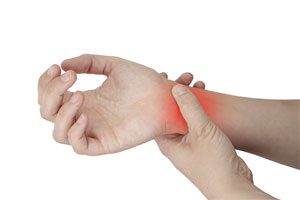
 I sprained my wrist two weeks ago. As a physiotherapist this was doubly problematic. I had athletes waiting eagerly for treatment and assistance with their fitness programmes, but I couldn’t even pick up a pencil or hold a cup of tea during the first few days after injuring my wrist. I am pleased to say that two weeks down the line I am back to work and almost 100 per cent pain free. I’d like to therefore impart some firsthand experience regarding some simple ways to treat an acute wrist sprain, or for that matter, any joint sprain.
I sprained my wrist two weeks ago. As a physiotherapist this was doubly problematic. I had athletes waiting eagerly for treatment and assistance with their fitness programmes, but I couldn’t even pick up a pencil or hold a cup of tea during the first few days after injuring my wrist. I am pleased to say that two weeks down the line I am back to work and almost 100 per cent pain free. I’d like to therefore impart some firsthand experience regarding some simple ways to treat an acute wrist sprain, or for that matter, any joint sprain.
Freeze the pain
The key in the first 2-3 days is to apply lots of ice to the injured joint as often as possible. But the trick lies in getting the temperature of the ice right. It’s not “the colder the better”, but “nice and comfortable, and sustained for longer” that helps. How do you tell that the temperature is just right? You should feel a nice cold sensation on the injured joint – the cold shouldn’t cause further pain. Use a plastic ziplock bag for your ice and add some water to it before putting in on your injured joint.
Wrap it up
Support is important in the first week. The ligaments are fragile and the wrist relies heavily on these ligaments to function, so a well-wrapped crepe or elastic bandage will do the trick.
My favourite bandage is the bandage that boxers use to support their wrists under their boxing gloves. It’s made from a durable hard wearing fabric that is easy to wash and dry. It has a loop that fits over your thumb and a velcro strap at the end so it is easy to secure and you don’t need to fight with it to get it to stay put like you would with a normal crepe bandage.
Heat and movement
After about eight days you can start using heat to loosen up your wrist and accelerate the healing process. By that time, the bleeding and swelling in the area should have settled and the application of heat shouldn’t increase the swelling in any way.
I would suggest putting about 5-7 litres of warm water in a container deep enough for your entire wrist and half your forearm to be submerged in the water. Gently move it around in the water. Always respect pain – work within the range comfortable to you. You can do this for about 20 mins.
Exercise with caution
By about the tenth day, you can start massaging the wrist and its surrounding muscles. Remember, be cautious. Try moving your wrist gently and gradually rotate it to move through the full range of the joint.
By the end of the second week, you can start some wrist strengthening exercises. Start with a 1 kg dumbbell. Sit at a table with the weight in your hand. Rest your forearm on the table so that your hand and wrist can hang off the side of the table. Gently curl the weight up as high as you can and then back down again. Repeat 10 to 20 times per set. Take a minute’s rest between sets and do three sets. Once you have completed your three sets, turn your palm to face upwards and repeat the same movement but with the opposite set of muscles this time.
Slowly progress by 1 kg each week until you can do the two exercises with a 4 kg dumbbell comfortably.
© HT Media